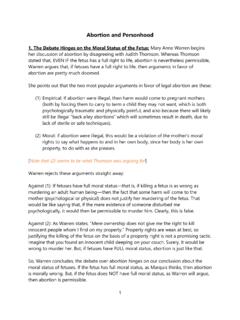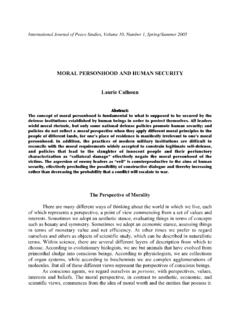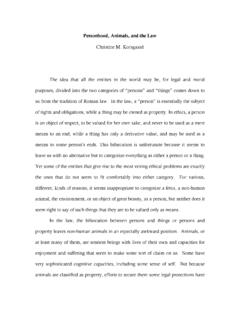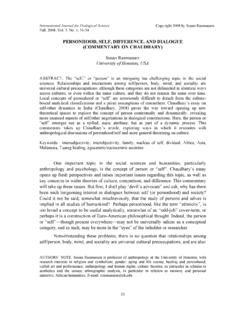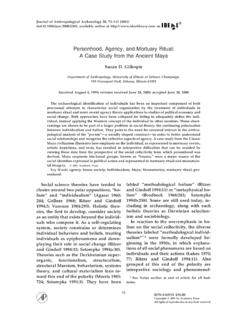Transcription of Personhood Measures: Extreme and Dangerous Attempts to …
1 Personhood Measures: Extreme and Dangerous Attempts to Ban Abortion For decades, opponents of legal abortion have tried every approach possible to make the procedure illegal again. In recent years, anti-choice legislative strategists have focused efforts most intensely on two tracks: They have imposed as many restrictions on abortion services as possible such as forced-ultrasound mandates, biased-counseling laws, and mandatory delays. And they have made it harder for low-income women and women who get their health insurance through the government to afford abortion care. Collectively, these approaches have significantly eroded women s reproductive freedom but they have not succeeded in making abortion illegal again nationwide. Frustrated by that fact, now the most strident anti-choice advocates are pushing for an all-out ban, and have chosen among the most far-reaching approaches to reach their goal: so-called Personhood measures.
2 Although details vary, Personhood measures typically change a state s definition of the word person to include a fertilized egg, embryo, or fetus, with the intent of outlawing abortion. As if this were not enough, most Personhood measures go far beyond an abortion ban also to sweep in most common forms of contraception, stem-cell research, and in vitro fertilization. Even worse, Personhood measures by their very definition have few if any exceptions to protect a woman s life or health. In sum, Personhood measures are a blatant attempt to take away a woman s ability to make reproductive-health-care decisions, including her constitutional right to choose safe, legal abortion. Personhood Measures: Sweeping Across the States In 2008 a number of local anti-choice groups founded an umbrella organization called Personhood USA. Its purpose was and is to press for Personhood measures across the country.
3 Over the past few years, Personhood efforts have manifested in two different ways: citizen-initiated ballot measures and None has become law yet, but as they proliferate across the states, it is evident that the threat is imminent. 1It is important to note that Personhood measures differ from proposals like the Unborn Victims of Violence Act (UVVA). Both are highly controversial and both change definitions of person or human in law, but UVVA measures typically are limited to certain criminal acts while Personhood proposals reach much more broadly. 2 In 2008, Colorado voters rejected an anti-choice Personhood ballot initiative by a three-to-one margin. Undeterred by this defeat, proponents put it on the ballot again in 2010, only to meet with a similar result. Despite these two losses, Personhood proponents vowed to continue their efforts.
4 In December 2011, the initiative failed to qualify for the ballot. For the 2014 ballot, Personhood Colorado changed tactics by changing the initiative s language to attempt to seem less Extreme , as well as changing the name of the campaign from Personhood to A Voice for Brady in an effort to obscure the campaign s true intent. Fortunately, voters saw through the ploy and defeated the measure 64-35. In 2011, voters in Mississippi, one of the nation s most conservative states, rejected Initiative 26, a so-called " Personhood " measure , by a margin of 42 to 58 percent. In 2012, anti-choice activists in Oklahoma launched a petition drive to put a Personhood initiative on the state s ballot. Two pro-choice litigation groups filed a lawsuit to block the signature-gathering campaign and the state supreme court ruled that defining a fertilized egg as a person is clearly unconstitutional. Proponents of the measure , however, declared their intent to petition the Supreme Court for reconsideration.
5 In October 2012, the Supreme Court declined to hear the Also in 2012, a non-binding resolution endorsing Personhood went before voters in Georgia s Republican primary, in which 66 percent voted in The resolution would have no legal effect; however, its mere consideration exemplifies how anti-choice activists are attempting to push Personhood into the mainstream anti-choice movement. In 2014, a Personhood ballot initiative also went before voters in North Dakota. Proponents of the initiative tried to distance themselves from its Extreme nature, going as far as saying it would not outlaw common forms of birth control. Despite the fact that North Dakota is a very conservative state, voters overwhelmingly defeated the measure 64-35. In 2016, no states enacted any Personhood measures, although nine states introduced 13 such Federal Efforts to Advance Personhood Measures In 2012, as the Senate prepared to debate legislation to reauthorize the National Flood Insurance program, Sen.
6 Rand Paul (R-KY) filed a Personhood amendment. Senate Majority Leader Harry Reid (D-NV) responded instantly to the threat, vowing to pull the entire unrelated bill if Paul did not back down. Sen. Paul ultimately chose not to offer his amendment. 3 In 2015, Reps. Alexander Mooney (R-WV), Walter Jones (R-NC), and Jody Hice (R-GA) introduced three separate measures to amend the Constitution to recognize life as beginning at conception ( , , ). These bills effectively would ban abortion nationwide in almost all This issue played heavily in the 2014 mid-term elections with cosponsors of the respective bills attempting to distance themselves from their previously held positions, declaring that the proposals were nothing more than a simple statement in support of Personhood Measures Have Far-Reaching Consequences Personhood measures are unconstitutional. The Supreme Court has long held that a woman has the right to choose abortion until the point of fetal viability.
7 Under this standard, states may regulate abortion care, but not ban it before However, Personhood measures ban abortion in almost all cases by redefining an embryo or a fetus as a legal person or stating that life begins at the moment of conception. Personhood measures would ban abortion outright and force women to seek illegal abortion care. Illegal abortion is extremely Dangerous . Each year, an estimated 42 million women worldwide obtain abortion services to end unplanned pregnancies; approximately 21 million of them obtain the procedure Complications due to unsafe abortion account for approximately 13 percent of maternal deaths worldwide, nearly 50,000 deaths a Where abortion is illegal, the risk of complications and maternal mortality is high. In fact, the abortion-related death rate is hundreds of times higher in developing regions, where the procedure is often illegal, than in developed countries.
8 9 Personhood measures could have drastic consequences. Should one become law and go into effect, a Personhood measure would have a profound impact on reproductive-health care services beyond legal abortion. Personhood measures would ban most common forms of birth control. Any form of contraceptive that prevents implantation, rather than or in addition to fertilization, would be banned. This would have an enormous impact on the 99 percent of American women who use birth The American Congress of Obstetricians and Gynecologists (ACOG) opposes 4 Personhood measures because they would erode women s basic rights to privacy and bodily integrity; deny women access to the full spectrum of preventive health undermine the doctor-patient relationship. 11 Personhood measures could also potentially ban embryonic stem-cell research. Because embryonic stem cells are obtained about five days after fertilization,12 research using these types of cells would be illegal if a Personhood measure were law.
9 In fact, Personhood Colorado refers to this immensely promising field of biomedical research as human harvesting. 13 Fertility groups oppose these measures. The National Infertility Association says Personhood amendments are clearly intended to outlaw abortion but have the potential to affect assisted reproductive embryos are full humans, anything that puts an embryo at risk could be a criminal violation, including the practice of cryopreservation. 14 Other Anti-Choice Groups Distance Themselves from the Personhood Strategy Although other anti-choice organizations share many of the same goals as Personhood USA, including making abortion illegal, they have criticized this approach: Federal courts would almost surely declare the amendment unconstitutional, said James Bopp Jr., general counsel of the National Right to Life Committee. 15 The anti-choice organization Eagle Forum calls Personhood measures a gimmick and says that nearly every reputable pro-life leader has criticized the approach of the Personhood amendment.
10 16 Clarke Forsythe of Americans United for Life has said, these Personhood proposals have the specific aim of challenging Roe, yet they are heading toward a brick wall. 17 Despite that, Personhood USA and its member organizations have placed the issue on the ballot in two states thus far, and claim activity in all 50. Conclusion Forty years after the Supreme Court recognized the right to choose and ended the national horror of illegal abortion, opponents continue to try to recriminalize the procedure. Personhood measures demonstrate one of the most Extreme Attempts on a woman s right to choose. Thankfully, Americans have, so far, seen through these tactics and recognize them as the latest approach to rolling back a woman s right to choose. However, should a Personhood measure make its way into law in even one state, it could have dire consequences for women and their families across the nation. 5 January 1, 2017 Notes: 1 Bill Mears, Supreme Court Rejects Abortion-Related Appeal, CNN, Oct.



